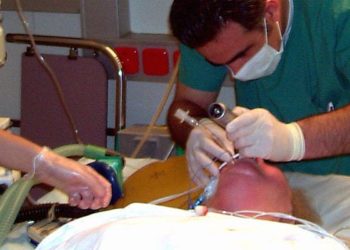Video laryngoscopy improves the first-attempt success rate of orotracheal intubation in infants
1. 93% of infants in the video laryngoscopy group were successfully intubated on first attempt compared to 88% in the direct laryngoscopy group.
2. Significantly fewer severe complications occurred in the video laryngoscopy group than in the direct laryngoscopy group.
Evidence Rating Level: 1 (Excellent)
Study Rundown: Orotracheal intubation is a common procedure done in children requiring surgery. However, unsuccessful and multiple attempts at intubations are associated with an increased risk of complications. Although video laryngoscopes generally have a higher first-attempt success rate than direct laryngoscopes, their utility in children without difficult airways is controversial. This multicenter, randomized controlled trial aimed to compare the first-attempt success rate of orotracheal intubation in infants using video laryngoscopy with a standard blade versus direct laryngoscopy. Primary outcome for this study was the proportion of patients with successful intubation on first attempt, while secondary outcomes included the number of intubation attempts, time to successful intubation, proportion of unsuccessful intubations, and proportion of non-severe and severe complications. According to study results, video laryngoscopy demonstrated a significantly increased rate of successful first-attempt intubations compared to direct laryngoscopy. In addition, there were fewer severe complications among infants in the video laryngoscopy group compared to the direct laryngoscopy. However, this study may benefit from adopting a standardized training approach for video laryngoscopy as most clinicians have more baseline training in direct laryngoscopy. Moreover, many clinicians performed more than one intubation; however, no association between clinician expertise and first-attempt success rate was reported. Overall, this study provides insight into the use of video laryngoscope with a standard blade for successful orotracheal intubation in infants.
Click to read the study in The Lancet
Relevant Reading: The usefulness of endotracheal tube twisting in facilitating tube delivery to glottis opening during GlideScope intubation in infants: randomized trial
In-depth [randomized controlled trial]: Between June 4, 2018, and August 19, 2019, 1859 infants were assessed for eligibility at four children’s hospitals in the USA and one in Australia. Included patients were those younger than 12 months, undergoing a non-cardiac procedure that required general anesthesia, and orotracheal intubation by an anesthesiology clinician. Patients with a history of difficult intubation, craniofacial abnormalities, or prediction of difficult intubation based on physical exam were excluded. Altogether, 552 infants were randomized (274 in the video laryngoscopy group and 278 in the direct laryngoscopy group) and included in the analysis. Baseline characteristics were similar between groups except for the greater proportion of infants born before 37 weeks’ gestation in the video laryngoscopy group.
Among enrolled infants, the mean age was 5.5 months (standard deviation [SD] 3.3). Primary outcome of successful first attempt at orotracheal intubation was observed among 254 (93%) infants in the video laryngoscopy group and 244 (88%) infants in the direct laryngoscopy group (adjusted absolute risk difference [ARD] 5.5%, 95% confidence interval [CI] 0.7 to 10.3, p=0.024). The likelihood of successful orotracheal intubation at first attempt varied by bodyweight, with smaller infants (≤6.5 kg; ) having a higher success rate with direct laryngoscopy than larger infants (>6.5 kg). Occurrence of severe complications was significantly lower in in the video laryngoscopy group (n=4, 2%) than in the direct laryngoscopy group (n=15, 5%; ARD -3.7%, 95% CI -6.5 to -0.9, p=0.0087). Similarly, the number needed to treat for successful orotracheal intubation was lower in the video laryngoscopy group (median 1, range 1-3) than in the direct laryngoscopy group (median 1, range 1-5, adjusted rate ratio 0.94, 95% CI 0.88-0.99, p=0.027). However, the time to successful intubation was greater than one minute for 15% of infants in the video laryngoscopy group compared to 10% in the direct laryngoscopy group. Findings from this study suggest that among infants presenting for elective surgery, the first-attempt success rate of orotracheal intubation was higher using video laryngoscopy with a standard blade than with direct laryngoscopy.
Image: PD
©2020 2 Minute Medicine, Inc. All rights reserved. No works may be reproduced without expressed written consent from 2 Minute Medicine, Inc. Inquire about licensing here. No article should be construed as medical advice and is not intended as such by the authors or by 2 Minute Medicine, Inc.









